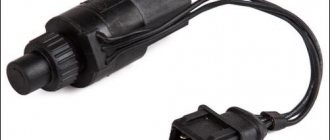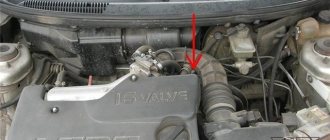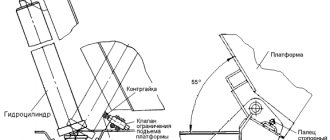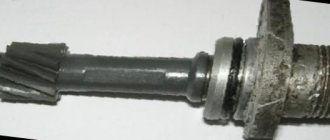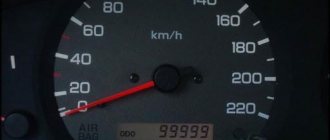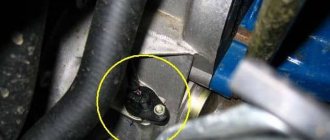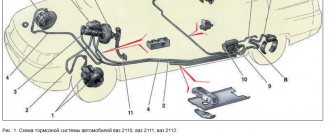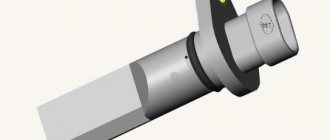Every modern vehicle uses a speed monitoring system so that the motorist can be aware of the driving speed. The elements that are part of this system must be working, since the motorist must know the speed of movement. What is the VAZ 2110 speed sensor used for, what malfunctions are typical for it, how to replace the device? We will talk about this below.
The VAZ 2110 speedometer does not work, what should I do?
The vast majority of VAZ 2110 cars are equipped with electronic odometers. They can disturb their owners with various malfunctions, which, as a rule, manifest themselves in different ways.
A speedometer is one of the main instruments of a car, which is used to measure the speed of a vehicle. Its breakdown, of course, does not lead to serious malfunctions in the operation of the car, but when the speedometer needle jumps from one indicator to another or even hangs at some value, it deprives the driver of the ability to control the speed of the car.
This can lead to both fines and more serious consequences. Therefore, if the VAZ 2110 speedometer does not work, it is necessary to carry out repairs, especially since this process can be quite easy and fast if the cause of the malfunction is correctly identified.
Malfunctions
On VAZ 2110 cars, the speed sensor can fail for several reasons:
- Oxidation of contacts. This is the most minor damage. However, it can cause the needle to drop to zero or jump. To eliminate it, you must thoroughly clean all contacts from dirt;
- Wire chafing. The main sign of this breakdown is that the needle falls or jumps after starting the engine. Such a malfunction is not always detected visually, since in some cases the wire may outwardly appear intact, but in fact has a break. To determine the location of the damage, you need to ring it using a special tester. A broken wire is often the cause of failure of the instrument panel, and in particular the speedometer;
- The sensor has stopped working. In order to make sure that the breakdown is correctly identified, you can take a new speed sensor and connect it. If the speedometer starts working after this, then the conclusion is obvious. Failure of the speed sensor may occur due to the housing not being sealed, as a result of which dirt, dust, and moisture can enter;
- Checking the connectors. In VAZ cars they are located in such a place that they are constantly in contact with dirt and quite often this is the main reason that the speedometer needle jumps or refuses to work at all, showing incorrect vehicle speed values;
- Drive unit. Also, the reason why the needle jumps on the speedometer may be wear of the shaft. With such a malfunction, the VAZ 2110 speedometer drive does not effectively transmit torque. It is worth noting that this is one of the most common reasons why the sensor needle jumps.
If the vehicle speed indicator does not work correctly, before purchasing a new device, you need to check all possible breakdowns and only then think about replacing it.
Replacement features
The speedometer is located on the main instrument panel. And if, after checking all possible reasons why the device does not work, it turns out that all the faults lie in the device itself, then the entire panel will have to be replaced, and not just this individual element.
Today, unfortunately, spare parts for dashboards are not sold and this complicates the entire replacement process. It is worth noting that when installing a new device, you can rewind the mileage indicators.
Replacement
If during diagnostics it was determined that the needle is falling or jumping as a result of a breakdown of the speed sensor itself, it needs to be replaced. This manipulation is quite simple, but still requires certain knowledge and skills from the car owner.
To replace the speed sensor you will need special keys. It is better to carry out manipulation from above the engine. First, you need to disconnect the battery ground and contact chips, then remove the device using a key. If the rod is broken, then you cannot do without removing the drive. Here you need to be especially careful.
If the arrow jumps, lies or freezes, then repairs must be made as soon as possible. It is better to entrust such work to professionals, since without the necessary experience and certain knowledge, replacing a device can be done poorly.
Only professionals at service stations can quickly remove and install new equipment. As a rule, such a procedure does not take much time and its cost is low.
DIY repair and replacement
If you decide to replace the device yourself, familiarize yourself with the removal and replacement procedure.
The controller is dismantled as follows:
- First you need to de-energize the vehicle's on-board network; to do this, disconnect the negative cable from the battery.
- Next, disconnect the wiring connector from the controller itself. At this stage, it is important to remember what pinout these elements have.
- The controller itself can be unscrewed by hand. If you can’t do this on your own, try using a 21 or 22 wrench. In this case, the regulator may have certain differences in design.
- Also immediately check how well the drive functions. After the regulator is removed, it is necessary to unscrew the nut that secures the drive to the gearbox. The dismantling procedure must be done very carefully, because if you accidentally drop the rod into the transmission, the box will need to be removed and disassembled. As for the new drive, it is equipped with a rubber seal. Before installation, it must be lubricated with transmission fluid. Below is a video that will allow you to more clearly understand the procedure for replacing the controller (the author of the video is Auto News).
All new components must be installed in reverse order. Again, in this case the wiring pinout plays a big role. Inside the block itself you can see how the pinout is indicated. Using a tester with the ignition activated, it is necessary to determine which connector the drive should be connected to.
If the multimeter shows “-” and the drive was connected to the positive connector, this indicates that the polarity needs to be changed. Next, the drive is diagnosed, and you should also check the operation of the speedometer while driving or with the front of the vehicle raised (so that the wheels are suspended).
If you doubt that you can carry out the entire procedure yourself and change the controller correctly, we advise you to seek help from specialists. In principle, this process is not particularly complicated, so the cost of the replacement service will not be particularly high. For installation, it is better to use a higher-quality regulator so that in the future you do not face the need to repair and replace it.
Reasons why the speedometer does not work on the VAZ 2110
The vast majority of VAZ 2110 cars are equipped with electronic odometers. They can disturb their owners with various malfunctions, which, as a rule, manifest themselves in different ways.
A speedometer is one of the main instruments of a car, which is used to measure the speed of a vehicle. Its breakdown, of course, does not lead to serious malfunctions in the operation of the car, but when the speedometer needle jumps from one indicator to another or even hangs at some value, it deprives the driver of the ability to control the speed of the car.
This can lead to both fines and more serious consequences. Therefore, if the VAZ 2110 speedometer does not work, it is necessary to carry out repairs, especially since this process can be quite easy and fast if the cause of the malfunction is correctly identified.
Malfunctions
On VAZ 2110 cars, the speed sensor can fail for several reasons:
- Oxidation of contacts. This is the most minor damage. However, it can cause the needle to drop to zero or jump. To eliminate it, you must thoroughly clean all contacts from dirt;
- Wire chafing. The main sign of this breakdown is that the needle falls or jumps after starting the engine. Such a malfunction is not always detected visually, since in some cases the wire may outwardly appear intact, but in fact has a break. To determine the location of the damage, you need to ring it using a special tester. A broken wire is often the cause of failure of the instrument panel, and in particular the speedometer;
- The sensor has stopped working. In order to make sure that the breakdown is correctly identified, you can take a new speed sensor and connect it. If the speedometer starts working after this, then the conclusion is obvious. Failure of the speed sensor may occur due to the housing not being sealed, as a result of which dirt, dust, and moisture can enter;
- Checking the connectors. In VAZ cars they are located in such a place that they are constantly in contact with dirt and quite often this is the main reason that the speedometer needle jumps or refuses to work at all, showing incorrect vehicle speed values;
- Drive unit. Also, the reason why the needle jumps on the speedometer may be wear of the shaft. With such a malfunction, the VAZ 2110 speedometer drive does not effectively transmit torque. It is worth noting that this is one of the most common reasons why the sensor needle jumps.
If the vehicle speed indicator does not work correctly, before purchasing a new device, you need to check all possible breakdowns and only then think about replacing it.
Replacement features
The speedometer is located on the main instrument panel. And if, after checking all possible reasons why the device does not work, it turns out that all the faults lie in the device itself, then the entire panel will have to be replaced, and not just this individual element.
Today, unfortunately, spare parts for dashboards are not sold and this complicates the entire replacement process. It is worth noting that when installing a new device, you can rewind the mileage indicators.
Replacement
If during diagnostics it was determined that the needle is falling or jumping as a result of a breakdown of the speed sensor itself, it needs to be replaced. This manipulation is quite simple, but still requires certain knowledge and skills from the car owner.
To replace the speed sensor you will need special keys. It is better to carry out manipulation from above the engine. First, you need to disconnect the battery ground and contact chips, then remove the device using a key. If the rod is broken, then you cannot do without removing the drive. Here you need to be especially careful.
If the arrow jumps, lies or freezes, then repairs must be made as soon as possible. It is better to entrust such work to professionals, since without the necessary experience and certain knowledge, replacing a device can be done poorly.
Only professionals at service stations can quickly remove and install new equipment. As a rule, such a procedure does not take much time and its cost is low.
Troubleshooting
To begin troubleshooting the problem, you first need to find the device. From the photo you can determine how the speed sensor on the VAZ 2110 looks externally.
Ears for fastening
As for its location, look in the engine compartment in close proximity to the exhaust manifold. They say frankly that the place where it is installed cannot be called ideal. It's all about the collector. While the car is running, the manifold heats up. The sensor wires rub against it, which over time leads to malfunctions and short circuits.
Therefore, experts recommend that the first step is to properly insulate the wiring, and also use some kind of clamps so that the wires do not come into contact with the collector. This significantly extends its service life.
Having checked the device visually and not determining the presence of breakdowns, this tells us that the element itself is faulty. This problem can be solved by replacing it.
What else is the reason for the speedometer not working?
However, often the reason for the speedometer malfunction lies elsewhere:
- Oil and dust get into the speed sensor, which is located in the engine compartment under the hood of the car.
The malfunction is eliminated after removing dirt and oil by washing the sensor. If the DS fails and needs to be replaced, any car owner can perform this simple operation independently. The replacement sequence is as follows:
- place the machine on a flat horizontal surface;
- open the hood and find the speed sensor on the gearbox;
- by pressing the latch bracket, the plug is disconnected from the DS:
- to remove the sensor, use a 22 mm wrench, turning it counterclockwise;
- The new part is installed by screwing it in by hand. The use of a wrench is not recommended, as you may miscalculate the rotation and break the thread;
- install the connector, as evidenced by the click of the fixed part.
The driver should buy a new DS with similar markings. Otherwise, the speedometer needle will display incorrect readings.
- For some unknown reason, the VAZ 2110 speedometer stopped working. First of all, you need to check the most accessible elements associated with the speedometer. Since the car compartments are not ideally clean, dirt and moisture can damage any part, including wires and contacts.
Under the influence of moisture and dirt, wires and contacts can oxidize. Eliminating this cause is simple: the contacts must be removed, cleaned of oxidized deposits, wiped dry and reinstalled. It is also necessary to check the integrity of the wires.
Externally good wires may have broken sections of cores inside. Checking the serviceability of the wires involves ringing their surface with a tester.
During operation, the splines and elements that rotate the speedometer cable may be damaged. Such a defect may impair the operation of the instrument panel. You can verify its serviceability by testing it.
- The third, very important defect is the malfunction of the speed sensor. This device is located on the gearbox, adjacent to the exhaust manifold. This factor leads to heating and chafing of the DC wires.
The reasons for the sensor being out of working condition, the fault can be determined at the service center. The technician will perform this procedure in the presence of the car owner. To troubleshoot the problem yourself, you should do the following:
- The speed sensor must be removed by unscrewing it from the gearbox;
- connect the DC wire to a screwdriver or drill, set the rotation counterclockwise;
- turn on the ignition.
The movement of the arrow indicates that the sensor is working properly. The weak link is most likely located in the vehicle's transmission. It is difficult for a driver without experience to cope with this task.
In this case, the problem must be solved by car service specialists. If the speedometer needle on a VAZ 2110 does not work, the speed sensor must be replaced.
The speedometer on a VAZ 2110 with an injector is an important element of any car, not excluding the “top ten”. VAZ 2110 drivers even with little experience can check and find the source of the malfunction of this device.
However, if you cannot determine the source of the speedometer problems, you need to draw the attention of technical service specialists to this problem.
As you know, devices installed in a car allow you to monitor the situation while driving on the streets and monitor the operation of the engine and all other systems. Among others, the speedometer occupies a special place. It is located on the dashboard directly above the steering wheel. With its help, the driver finds out at what speed the car is moving.
In a situation when the speedometer and the injector installed on the VAZ-2110 do not work properly, the person behind the wheel puts both his own health and the lives of passengers at risk. At the same time, he can easily “earn” a fine from a traffic police officer for speeding too high. Thus, a working speedometer allows you to avoid a considerable amount of trouble.
Installing a new element
Before replacing the speed sensor, you should purchase a new element that matches the shape of the connector. It is necessary to take into account an important point: on the connecting block of the factory product, near the contacts, the marking numbers “1”, “2” and “3” are marked. But on sale there are more often sensors where a different marking scheme is adopted; instead of numbers there are symbols “-”, “+” and “A”. There is no tragedy in this, you just need to know that the new speed sensor pinout is combined with the old one as follows:
- the symbol “+” and the number “1” are the same thing;
- the symbol "-" means "3";
- the letter “A” is the output wire, corresponds to the number “2”.
In addition to the contact group, when purchasing, you should pay attention to the material from which the element drive, combined with the gearbox shaft, is made. It is recommended to buy a sensor with a metal drive, since plastic parts are not durable.
Replacing the sensor is a simple task, performed in the following sequence:
- Turn off the ignition and remove the negative contact from the battery.
- For ease of access, disconnect and remove the air filter along with the air duct pipe.
- Disconnect the connection block.
- Unscrew the element, grabbing it by the edges with a 22 key.
- Clean and wipe the area from dirt, screw in the new sensor along with the gasket.
https://www.youtube.com/watch?v=x_BfBpNW9zEWhen finished, connect the wires, put the removed parts back in place and check the functionality of the sensor while driving using the speedometer.
Any car is equipped with a system that shows the speed of movement and mileage (distance traveled). It is the speedometer, which is a device for determining instantaneous speed, that makes it possible to find out what the maximum speed of the VAZ 2110 is.
Speed sensors are installed only in fuel-injected cars; where carburetor engines are present, they are not present. This device is responsible for the supply and consumption of fuel, setting the ignition timing, and monitors the quality of the combustible mixture. All data is transmitted to the electronic control unit, which controls the injector.
Causes of malfunction of the speed sensor.
Speed sensor VAZ 2110
If the speed indicators on the dashboard do not correspond to reality, this does not mean that the speed sensor has failed. Although the price of the sensor is relatively low and replacing it is quite simple, you should not do this until it is fully confirmed that it is at fault for the malfunction.
The reasons for the failure of the speed sensor may be:
- The presence of traces of oil or deposits of dust and dirt on the surface of the device. Due to contamination of the sensor, the signal is distorted and incorrect speed readings are displayed on the dashboard. In this case, the problem can be solved quite simply - you need to check the surface for dirt and clean it.
- Violation of the tightness of the conductors, or loss of communication with the ECU. Violation of the sensor structure and its subsequent failure, or extraneous mechanical influences on the speedometer conductor. Thus, the cable may move unevenly or touch the external protection, thereby complicating the move and dulling the signal. In this regard, the correct functioning of the car speed sensor is disrupted. Also, the analyzer will not work correctly with increased cable vibrations.
Why does the speed sensor fail?
The reasons are mechanical and electrical. Let's list each one separately.
Mechanical reasons include:
- wear of gear teeth both on the manual transmission shaft and on the adapter - speed transformer;
- the appearance of play in the connection between the transformer shaft and the sensor itself;
- displacement or loss of the Hall element on the moving part;
- contamination of a pair of Hall elements inside the housing;
- physical damage to the shaft or housing.
Electrical reasons:
- failure of electronics (cannot be repaired);
- oxidation of connector contacts;
- chafing of device wires due to poor location;
- external interference from the injector control loop or high-voltage spark plug wire;
- interference created by non-standard electrical devices (such as a xenon driver or a security alarm unit).
Signs and causes of DS (speed sensor) problems
Failure of the speed sensor can be determined visually during a trip. This occurs when the speedometer needle jumps, gives clearly incorrect readings, or falls to the zero mark. If, at the same time, the odometer ceases to determine the distance traveled, then the most likely cause of the breakdown is sensor failure.
Additional signs of a malfunction may include uneven operation of the power unit at idle, as well as too high fuel consumption.
Speed sensor device
Why doesn't DS work? There may be several reasons:
- The terminal block is dirty;
- Contacts are oxidized;
- The wiring is frayed or melted;
- No contact due to a loose connector;
- Damage to the sensor itself.
The device is installed under the hood next to the exhaust manifold, on the gearbox. It is exposed to oil vapors and is poorly protected from dirt. The sensor wire may fray or melt due to being near very hot elements of the car. On a VAZ 2110 with an injector, this often leads to the disappearance of contact and the cessation of signal transmission to the speedometer.
An unambiguous answer about the serviceability of the sensor can be obtained by replacing it
However, when buying a DS, you need to pay attention to its model. Firstly, you should make sure that it is compatible with the previous one, and secondly, it is recommended to pay attention to the material of the rod
It is preferable to purchase a sensor with a metal drive rod rather than a plastic one.
Sensor with metal rod
This design is highly reliable and will last quite a long time, while a plastic one can fail within a few months.
When purchasing a device, it is important to make sure that there is a washer on the rod, there are no backlashes, and that the kit corresponds to the attached documentation for the sensor
All of the above questions are related only to injectors, because in carburetor systems there is no DS as such. Torque is transmitted to a mechanical speedometer using a cable system, without any electrical converters.
Preparing for replacement
In order for the procedure for replacing the controller on the tenth VAZ model to proceed correctly and to obtain the expected result, namely the normal functioning of the speedometer, you should be properly prepared for this process.
Firstly, on a VAZ 2110, replacing the DC means purchasing a new controller. When purchasing a new regulator, you need to pay attention to the fact that each connector located in the block design has certain symbols. It should contain the symbols “-”, “A” and “+”, not numbers. In principle, in this case there is not much difference between these options; when connecting the connector you will have fewer problems with pinout. If you have never encountered a process like this, this pinout will allow you to complete it correctly.
Controller connector pinout
One more, no less important nuance. You need to buy a device that is equipped with a metal rod. This rod will last at least six months, which cannot be said about regulators with plastic rods. In addition, when purchasing, you must check whether the rod rotates or not. It should not rotate, there should be no play on this element, and it should also be equipped with a washer.
Wiring pinout, what to pay special attention to when using a multimeter
Pay attention to the pinout inside the block. With the ignition on, use a multimeter to determine which connector is connected to which wire. If you connect the wire to the “plus” connector, and the multimeter shows “minus”, then you should urgently change the polarity. Therefore, it is advisable to take a block with the appropriate designations. But if this doesn’t happen, you can take the regular one. In this case, the pinout is as follows - 1 is “+”, 2 is “signal output”, and 3 is “-“.
Speed sensor pinout
If you understand how to connect a speed sensor, you should know that these devices differ in the degree of connection. There is the following pinout of the VAZ 2110 speed sensor, which should be followed. In this case, it is very important to study the circuit diagram of the speed sensor, which is attached to this article.
The factory speed sensor of VAZ 2110 cars is manufactured with some differences in connections to the shoe connector. The square-shaped connector is used in Bosh electronics systems. The circle-shaped connector is used in electronic systems such as January 4 and GM.
When connecting a speed sensor, you should choose devices with contact group digitization such as “-”, “A”, “+” (internal designation on the block contacts) instead of digital designations such as “1”, “2”, “3”. In addition, preference should be given to devices with a metal-type rod, since plastic rods are very short-lived.
Having decided to buy a speed sensor for a VAZ 2110, you should check the rod of the device with rotational movements and its backlash, which should be kept to a minimum, as well as the presence of such a part as a spacer washer on the rod of the product.
Pinout DS 2109, 2110, 2112, 2114, 2115
If you understand how to connect the speed sensor, then there is the following pinout that you should follow. At the same time, it is important to understand the essence of the operation of the DS to study the circuit diagram of the sensor, which is attached to this article.
The factory speed sensor of VAZ cars is manufactured with some differences in connections to the block connector. The square-shaped connector is used in Bosh electronics systems. The circle-shaped connector is used in electronic systems such as January 4 and GM.
When connecting a sensor, you should choose devices with contact group digitization such as “-”, “A”, “+” (internal designation on the block contacts) instead of digital designations such as “1”, “2”, “3”. In addition, preference should be given to devices with a metal-type rod, since plastic rods are very short-lived.
Replacing the VAZ 2110 speed sensor
The main cause of speedometer problems is a failure of the speed sensor, and if the DS is faulty, it must be changed. It is not difficult to replace the sensor on a VAZ “ten”; almost any driver can do this work independently. The operation is especially simple on a car with an 8-valve engine. Let's start replacing:
- we place the car on a flat horizontal plane; you can do without a pit or a car lift;
- we find the sensor - it is located on top of the gearbox housing, not far from the oil dipstick;
- to disconnect the plug from the sensor, press the locking bracket;
- use the key » 22 counterclockwise to turn off the sensor itself, often the DS is turned away by hand;
- When installing a new part, we use manual force; it is not recommended to tighten the DS with a wrench, as you can break the part or strip the thread.
When installing, we put the connector in place, it should click into place, and the work can be considered complete. With sufficient skill, this operation is completed in 5-10 minutes.
Car owners often encounter a problem when, after replacing the sensor, the speedometer needle begins to “lie” - show the wrong speed. It should be noted that several types of DS have been developed for the VAZ “Ten”, and they have different catalog numbers
When purchasing, you should pay attention to the number that the sensor has failed, and you must purchase a new part only with the same marking
Types of speed sensors, their differences. Where is the speed sensor located?
- Electronic 6-pulse sensors are equipped with cars with injection engines, launched into series since 2006.
- On carburetor Samaras you can sometimes find 10-pulse EMF.
Until 2006, VAZ cars used mechanical devices in the form of special inserts between the speed indicator cables and the gearbox gear outputs.
The key difference between different types of EMF is the absence of wires and connecting connectors. For example, GM or Yantar systems are equipped with products with round (oval) ports. At the same time, Bosh uses wireless versions with square connectors.
On the VAZ-2110 (2111, 2112), speed sensors are mounted on the gearbox housings slightly to the right along the route, directly next to the oil control dipstick.
The device is easy to find by looking in the area of the right CV joint.
On the VAZ-2115, the electronic device is mounted on top of the front part of the gearbox (along the way) directly above the differential. The product with the connected cable is secured with one bolt on the box body.
All instruments on the VAZ 10 that indicate the speed of the vehicle are pointers, and signs of a malfunction are determined by deviations from the norm of the speedometer needle. If the speedometer is faulty, the arrow when the car is moving:
- does not deviate from zero, that is, does not show speed at all;
- stuck in one position, does not move in any direction;
- jumps, sharply changing readings, while the displayed speed does not correspond to reality.
There are other signs of a faulty speedometer, for example, the device works on a cold engine, and its readings correspond to the norm. As the engine warms up completely, the needle freezes and stops moving.
The main reason why the speedometer on a VAZ-2110 injector does not work is contamination (oiling) of the speed sensor (DS), failure especially often occurs if oil from the gearbox or engine gets onto the DS (for example, there is a leak from the valve cover of the internal combustion engine ). There are also other reasons:
- the speedometer itself has failed;
- the speed sensor is broken (this part on AvtoVAZ cars is not highly reliable);
- there is no normal contact in the DS plug or a break (short circuit) of the wires has occurred;
- The speedometer drive gears installed in the gearbox broke.
Principle of operation
The VAZ-2110 tachometer works according to the standard principle. It is part of an electrical circuit with the following elements:
- The device itself is located on the dashboard of the car and is completely electronic.
- The ignition module operates on the principle of an inductor. Necessary for converting direct current into pulsed current.
- Crankshaft position sensor or DPKV. It also converts electrical voltage into pulsed voltage.
- On-board computer or ECU. It is a receiver of pulse signals. Based on the frequency of incoming pulses, it makes calculations for the injection system, and also converts them into electrical voltage, adjusting the operation of the tachometer.
The whole circuit works as follows:
- After the power unit has started working, the crankshaft position sensor begins transmitting signals to the computer. Magnetic type crankshaft position sensor. Reacts to the absence of one tooth of the engine drive gear. As soon as an empty space passes near the sensor, it opens, thereby creating a pulse. For one revolution of the shaft, 1 pulse is created.
- The ignition module on the 8-valve version 2110 operates on the principle of generating pulse signals without rotation; it is stationary. The pulses are generated by 2 inductive coils. For one revolution of the power unit, 2 pulses are generated from the module. Due to pulses from the DPKV, the on-board computer transmits the discharge current to the ignition module.
- The pulse current transmitted from the DPKV to the ECU is converted into a constant voltage, which is transmitted to the tachometer receiver unit. The strength of the incoming current determines the strength of the magnetic field formed by the device’s coil, and therefore the angle of deflection of the tachometer needle.
The whole system is simple, consisting of a small number of elements. But any problem causes interruptions in the operation of the engine and the tachometer itself.
Next, a description will be given of the main symptoms that precede the tachometer failure.
Vehicle traffic control
This function is performed by the speed sensor, which takes part in the formation of the fuel mixture by the controller. It replaced the mechanical cable drive previously installed on carburetor VAZ 2112 models. The operating diagram of the element is as follows:
- The speed sensor is driven from a shaft located inside the gearbox.
- From the controller side, the device receives a reference voltage of 12 V.
- In response, the sensor produces a signal in the form of a pulse of a certain frequency. The frequency varies depending on the speed of the car.
- Based on these pulses, the controller controls the speed indicator and odometer on the dashboard, and also creates a rich or lean fuel mixture for the engine.
How much does a replacement cost?
If the breakdown is not due to dirty contacts or broken wiring, it is better to replace the sensor. Moreover, it costs 170-400 rubles, depending on the type and manufacturer. The cost of replacing it at a service station is 100-150 rubles.
Sensor part numbers:
- with mechanical drive - 2110-3843010F;
- electronic (new) - 2170-3843010.
When choosing a DS, pay attention to where it was manufactured. If a mechanically driven sensor requires replacement, under no circumstances buy Asian analogues - the drive gear is made of very low quality plastic
It happens that it breaks on the third day of use. In this case, you will have to disassemble the entire box to remove its fragments.
It is better to purchase a sensor with an all-metal drive.
Video on the topic
Good publicity
Home » Repair » VAZ 2110 – 2112 » The speed sensor (DS) is designed to obtain information about the number of revolutions transmitted from the gearbox to the drive wheels of the vehicle, followed by its conversion into an electronic signal and transmission to the electronic control unit (ECU). Only fuel-injected cars are equipped with DS. The predecessor of the speed sensor was a mechanical speedometer drive, which was equipped with all carburetor engines.
VAZ 2110 cars, depending on the year of manufacture, are equipped with different types of speed sensors. Older models are equipped with a mechanically driven sensor (rod and gear), new ones (after 2006) have a fully electronic design.
Electronic speed sensor
Symptoms of problems, checking the speed sensor
If the odometer is not working, and the speedometer is “jerky”, transmitting false speed or mileage readings, we can conclude that the speed sensor is faulty.
There is also the possibility that these are signs of electrical circuit problems, especially if the car has ever been tampered with. There may be a break or oxidation of the connectors, rubbing of the wiring insulation, which causes a short circuit.
Also, a sign of breakdowns are cases in which the car may stall at idle. Perhaps the most obvious symptom of a speed sensor failure will be incorrect speedometer readings and the “ChekEngine” light on the panel.
These devices have three contacts: ground, pulse signal, voltage. First, you should check the functionality of the grounding and the presence of voltage.
To check the speed sensor you need:
- Remove this sensor;
- Using a multimeter, calculate the contact that produces a pulse signal. “We install a plus to it, and attach the minus to the body of the car.
- Carefully rotate its rod. At the same time, you should monitor the output signal. If the sensor rod starts to rotate faster, the voltage will be higher.
Symptoms of a problem
Typical signs of a malfunctioning speed sensor on a VAZ 2110 car are as follows:
- unstable operation and incorrect speedometer and odometer readings;
- cessation of stable engine operation at idle;
- errors generated by the computer (P0500 – no sensor signal, P0503 – intermittent sensor signal).
The problems listed above may result from:
- poor contact in the sensor connector due to contamination;
- violation of the integrity of the wiring from the sensor to the ECU;
- mechanical failure of the DS drive (in older VAZ 2110 models).
Usually installing a new sensor solves all problems associated with it. The engine begins to operate in normal mode, and the speedometer and odometer show accurate information. If the problem does not disappear after installing a new DS, look for it elsewhere.
Owners of VAZ cars of the “tenth” family who service their “iron horses” themselves often have a question about where the 2110 sensors are located. Of no less interest is the problem of diagnosing and replacing them with their own hands. Everyone knows the devices that monitor oil pressure and engine temperature.
But in modern “dozens” there are many more such elements, each of them, together with the controller, performs its own task. One of the important parts that replaced the outdated cable drive is the VAZ 2110 speed sensor.
Diagnostics
Troubleshooting begins by disconnecting the wiring block from the speed sensor harness and checking them using a test light.
To make a control light bulb, you need any car lamp that can operate at a voltage of 12 V, and two wires about 1 meter long each. One of the wires is attached to the positive terminal, the second - to the negative terminal of the lamp. The resulting device also includes a Krona battery.
To carry out the test, one wire of the warning lamp is attached to the ground of the body or battery, and the second is made with short, frequent touches to the middle contact of the DC connector. If there are no faults in the connector-speedometer section, the speedometer needle will slightly tremble or rise. If the needle shakes, the answer to the question why the speedometer does not work can be considered found - the speed sensor requires replacement.
In cases where the needle’s response to tapping on the central contact of the block cannot be detected, it is necessary to “test” the speedometer power circuit. The procedure is carried out using a multimeter (multitester), or by using the same light bulb - a control.
The wiring harness is first disconnected not only from the speed sensor block, but also from the speedometer itself. One terminal of the tester or warning lamp is connected to the end of the wire located under the hood, the other to the interior end of the speed meter current supply circuit.
If the tester in the “continuity” mode indicates a violation of the integrity of the circuit, further troubleshooting is carried out in this direction. It is necessary to check the fuses, the connection points of the wires, and their integrity inside the insulating braid.
The search area can be reduced by gradually “ringing” individual sections of the circuit. On model 2114 and other VAZ products, the cause of speedometer failure is often oxidation of the “mass” contacts attached to the car body.
In cases where the speedometer needle does not work, but there is no evidence of malfunctions in the electrical supply circuit, a logical conclusion is drawn about the malfunction of the device itself. Additional testing can be done by temporarily installing a known good instrument panel.
Some recommendations
- The search for the cause of the speedometer's inoperability should begin with an external inspection of the DS and the wires going to it. Wires often break in close proximity to the plug.
- If the speed sensor is covered with a layer of dirt or oily, you need to remove it, wipe it, reinstall it and check the speedometer readings again. Perhaps after this the instrument needle will again begin to show speed normally.
- If you cannot figure out the problem yourself, you should contact an electrician at a car service center.
Causes of malfunction of the speed sensor
The absence of speedometer readings does not mean failure of the device. Although, to buy a speed sensor for a “ten”, it is enough to spend a small amount, but it will be very disappointing that the fact of replacing the speed sensor will not give the desired effect. And the reasons may be the following:
- The presence of dirt, dust and oil smudges on the speed sensor, a video on replacing which can be found on the Internet. They form on the body of the product during vehicle operation. To prevent the product in this case, you just need to clean the device.
- Unstable contact of the product connector and broken wiring.
- Sometimes the defect is of a purely mechanical nature, which consists of banal defects in the cable of the instrument speed indicator - speedometer.
The following options are possible here:
1. Complicated uneven movement of a braided cable, which is caused by cable defects - burrs or ruptures of the metal strands of the cable. They can significantly affect the functionality of the sensor drive. 2. Increased cable speed.
Checking the device for serviceability:
- We hang the front wheel of the vehicle on a jack.
- We disconnect the wire contact from the product and connect a digital multimeter or similar device to it
- Making rotational movements with the hanging wheel at low speed, we measure the pulse flow signal from the connector. The functionality test begins with checking the grounding and power supply of the electrical circuit.
- We remove the device from its seat.
- We connect the device for measuring voltage to the output contacts.
- By turning the speed sensor drive, we measure its potential difference.
- The output should produce data in which, as the rotor speed increases, the frequency and voltage of the output power increases.
The functionality of the device is considered satisfactory if, during diagnostics, it shows the frequency and voltage parameters at the output contact. Otherwise, replacing the speed sensor of the VAZ “Ten” cannot be avoided.
Purpose and principle of operation of the speed sensor
The functionality of a device such as the VAZ 2110 speed sensor is based on the use of the so-called. Hall effect, i.e. a stream of pulses is transmitted from the device to the vehicle's ECU, the frequency of which is in direct proportion to the speed of the vehicle. The electronic center of the car, analyzing the incoming data, selects the required idle speed and sends a signal to the device that regulates the engine idle speed, which optimizes the composition of the air-droplet mixture entering the combustion chamber, bypassing the vehicle throttle valve.
During a distance of one kilometer, the speed sensor, a photo of which can be seen on our portal, transmits over 6 thousand pulses to the ECU. Based on the parameters of the time analysis of interpulse signals, the on-board computer transmits the data to the dashboard, thereby determining the speedometer readings.
There is another useful function of the VAZ 2110 speed sensor, the diagram of which is presented on our resource. This is fuel efficiency. The device signals to the controller that the car is moving at a speed of 100 km/h. The throttle valve sensor transmits a signal to the controller when the driver stops pressing the accelerator pedal. The controller receives an impulse indicating the braking mode of the power plant and turns off the fuel system.
Why the speedometer does not work on a VAZ-2112: the main reasons for a 16 valve engine
When the speedometer does not work on a VAZ-2112 hatchback, the reasons may be different. Usually they try to repair the tidy, but the speed sensor turns out to be faulty. The ECU detects a malfunction of this sensor with difficulty, and the CHECK lamp does not turn on. The fact that the speed sensor is broken has to be identified by the following signs: idle speed always remains low, and the engine stalls when changing gears. These nuances will be discussed in more detail below, but we will only talk about 16-valve valves.
If all devices do not work, then one fuse is at fault. The video shows which one.
Electrical diagram
The sensor itself is powered by a voltage of 12 Volts (pink-black cord), and another pin is connected to ground. The gray wire is the sensor output. It is connected to the voltage source through a resistor (see figure).
Typical connection diagram for DS on a VAZ-2112
The diagram shows that the output is connected to the ECU terminal. Terminal number:
- 9 – block January 5.1, also BOSCH M1.5.4N (engine 21120, 1.5 l);
- 59 – BOSCH M7.9.7 module (ICE 21124, 1.6 l).
Another gray cord goes to the “red” block on the dashboard, where it connects to terminal 9.
As you can see, everything is elementary.
Instrument panel test on video (speedometer self-diagnosis)
There are some things we don't specifically consider.
Power to the circuit shown in the previous chapter comes from main relay 6. It is also called the “ignition relay”. There is also fuse 1 in the circuit.
Additional relay and fuse box
When the ignition circuit is broken, both the speedometer and the ECU module do not work on the VAZ-2112, and the engine does not start at all. So advice about checking the relay would seem stupid.
Advice for those who have an oscilloscope
If you still decide to dismantle the sensor, connect a 1 kOhm resistor to its output (to the middle terminal). The resistor tap is connected to the “plus” of the power supply. By turning the shaft by hand, pulses can be observed at terminal 2. There are six pulses per revolution.
Mechanics
The following diagram shows exactly how the speed sensor is designed.
Speed sensor for VAZ-2112
- 2110-3843010-13 – sensor;
- 2110-3843010-18 – sensor;
- 2108-3802820-10 – speedometer drive;
- 2101-3802718 – gasket;
- 2108-3802822 – drive housing;
- 2108-3802830 – sealing ring;
- 2108-3802834-20 – driven gear;
- 2108-3802833-20 – drive gear;
- 2101-3802717 – washer;
- 15896211 – M6 nut;
- 12601271 – wavy washer;
- 11500121 – pin M6x14.
Elements 1 and 2 are interchangeable.
Dismantling
To remove the sensor from the car, you need to disconnect its connector. The sensor housing is fixed near the CV joint - the desired point is shown by an arrow.
First step in dismantling
When the connector is disconnected, take a flat key “22” and unscrew the plastic nut. Then you can change the sensor or repair it.
What you need here is a flat key
To replace the sensor drive, use a “10” key to unscrew the M6 nut and remove it together with the washer. The drive housing is rocked from side to side - you need a 14mm spanner.
Dashboard connectors and speedometer contacts
The dashboard, as well as the speedometer on the VAZ-2112, may not work when they are disconnected from ground or power. Be aware that the speedometer receives power separately from the instrument panel. This also applies to the “mass”. Wiring:
- X2-2: +12V for speedometer;
- X2-3: speedometer “ground”;
- X1-9, X1-10: power supply for tidy;
- X1-1: “mass” of the tidy.
Connector X2 is painted red, X1 – white. Terminals 8 and 9 in connector X2 are the speedometer output and input. The output is connected to the on-board computer.
Both terminals (X1-9 and X2-2) are connected to one wire - orange. This line is protected by a fuse installed in the main mounting block (F19).
How to remove the tidy
First, disconnect the negative terminal of the battery. Then use a screwdriver to unscrew the 4 screws (photos 1 and 2) to remove the frame with glass.
Removing the dashboard
In the second step, unscrew the two screws holding the dashboard in place (photo 3). Next, compress the petal brackets to remove the tidy completely.
- If you connect the battery and turn on the ignition, the orange cord (connectors X1 and X2) should receive voltage “+12”;
- The presence of “ground” at terminal X2-2 is also a very important indicator;
- The gray cord (terminal X2-9) is usually called “+12”, and in rare cases - “ground”. When moving, pulses should appear at this terminal.
Sometimes they do this: they make a tap from terminal 9, and, without engaging the gear, move (push) the car. The engine remains switched off. Pulses will appear on the tap, detectable even with a voltmeter. The voltmeter itself must be a pointer type.
It will not be possible to fix a faulty speedometer - it will be easier to replace it. But first you need to find out exactly what the problem was.
How to check the speed sensor for functionality
Symptoms of defects in this device are as follows:
- suspension of engine operation during translational movement in idle mode and incorrect speedometer values being presented at the same time;
- When defects are detected in the electrical circuit of the speed sensor, the price of which is quite reasonable, the light banner “CHECK” is displayed with parallel recording of the error code “24” in RAM.
Important: such a recording is also possible in case of defects in the operation of the mass air flow sensor, but since the “CHECK” banner in this version is not constantly displayed, it is possible that this difference will indirectly indicate which device failed in operation
The “CHECK” banner in this version is not constantly displayed, then perhaps this difference will indirectly indicate which device has failed in operation.
Mechanics
The following diagram shows exactly how the speed sensor is designed.
Speed sensor for VAZ-2112
- 2110-3843010-13 – sensor;
- 2110-3843010-18 – sensor;
- 2108-3802820-10 – speedometer drive;
- 2101-3802718 – gasket;
- 2108-3802822 – drive housing;
- 2108-3802830 – sealing ring;
- 2108-3802834-20 – driven gear;
- 2108-3802833-20 – drive gear;
- 2101-3802717 – washer;
- 15896211 – M6 nut;
- 12601271 – wavy washer;
- 11500121 – pin M6x14.
Elements 1 and 2 are interchangeable.
Dismantling
To remove the sensor from the car, you need to disconnect its connector. The sensor housing is fixed near the CV joint - the desired point is shown by an arrow.
First step in dismantling
When the connector is disconnected, take a flat key “22” and unscrew the plastic nut. Then you can change the sensor or repair it.
What you need here is a flat key
To replace the sensor drive, use a “10” key to unscrew the M6 nut and remove it together with the washer. The drive housing is rocked from side to side - you need a 14mm spanner.
Replacement
The process of replacing a diesel engine is very simple, and even the most uninitiated car owner can cope with it.
Required tools:
- key to 21;
- key to 10;
- crosshead screwdriver.
Execution procedure for VAZ 2110 with drive sensors.
1.Raise the hood, disconnect the “-” terminal on the battery.
2. Determine the location of the sensor. For both old and new models, it is located on the back of the engine at the top of the gearbox.
3.If necessary, use a screwdriver to loosen the corrugation clamp, remove it, and move it aside.
4.Squeezing the antennae on the sensor connector, disconnect
5.Use your hands or using a 21 wrench to unscrew the sensor.
6.Using a 10mm wrench, unscrew the nut securing the DS drive and carefully remove it.
7.If the drive is in order, you can leave the old one, but if it has traces of mechanical stress, we replace it.
8. Having installed the drive, install a new sensor by screwing it clockwise.
9.Connect the connector, connect the corrugation, and the negative terminal.
10.Check.
Changing the electronic sensor
1.De-energize the vehicle's on-board circuit.
2. Using a screwdriver, loosen the corrugation clamp and remove it.
3. Disconnect the wires from the DC by moving the latch.
4.Using a 10mm wrench, unscrew the sensor mounting nut.
5.Remove the old sensor, install the new one, tighten the nut.
6. Connect the corrugation.
7.Connect the ground terminal.
How to remove the tidy
First, disconnect the negative terminal of the battery. Then use a screwdriver to unscrew the 4 screws (photos 1 and 2) to remove the frame with glass.
None A little test:
- If you connect the battery and turn on the ignition, the orange cord (connectors X1 and X2) should receive voltage “+12”;
- The presence of “ground” at terminal X2-2 is also a very important indicator;
- The gray cord (terminal X2-9) is usually called “+12”, and in rare cases - “ground”. When moving, pulses should appear at this terminal.
Sometimes they do this: they make a tap from terminal 9, and, without engaging the gear, move (push) the car. The engine remains switched off. Pulses will appear on the tap, detectable even with a voltmeter. The voltmeter itself must be a pointer type.


